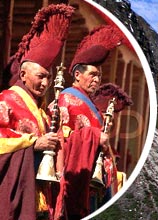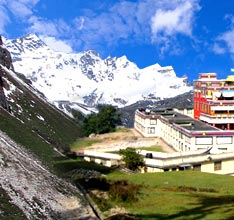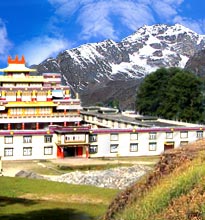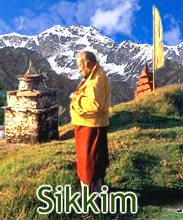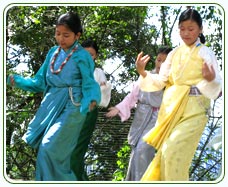 The
cultural heritage of Sikkim is expressed in its traditional folk dances.
Sikkim is domiciled by many ethnic castes and tribes; each of them has
its own interesting folk dances. The major inhabitants of Sikkim are
divided into three communities, the Lepchas, the Bhutias and the
Nepalese respectively. The folk dances and music have become an
inseparable part of Sikkim Culture. A majority of the dances are
associated with the startling beauty of the natural environs. Some of
them depict the harvest season and other dances are performed for
opulence. The traditional dances of Sikkim go together with the tunes of
many musical instruments.
The
cultural heritage of Sikkim is expressed in its traditional folk dances.
Sikkim is domiciled by many ethnic castes and tribes; each of them has
its own interesting folk dances. The major inhabitants of Sikkim are
divided into three communities, the Lepchas, the Bhutias and the
Nepalese respectively. The folk dances and music have become an
inseparable part of Sikkim Culture. A majority of the dances are
associated with the startling beauty of the natural environs. Some of
them depict the harvest season and other dances are performed for
opulence. The traditional dances of Sikkim go together with the tunes of
many musical instruments.Mask Dance is the renowned dance of Sikkimese people. Singhi Chaam and Yak Chaam are the popular Tibetan dance forms. The various dances of the Bhutias are Lu Khangthamo, Gha to Kito, Chi Rimu, Gnungmala Gnunghey, Be Yu Mista and Tashi Zaldha. Maruni, Tamang Selo, Dhaan Naach, Dau Ra Jane and Sebru Naach are different dance forms of the Nepalese. The Lepchas enjoy Zo-Mal-Lok, Chu Faat, Kar Gnok Lok, Dharma Jo, Mon Dryak Loks, Tendong Lho Faat and Mun Hait Lok. Rechungma and Talachi have been known as Sikkimese dance forms. All these communities have their own dance forms. In this article, we would discuss the major ones in brief.
Lu Khangthamo
Lu Khangthamo is a Bhutia folk dance that is celebrated to thank all the Gods and deities of the three worlds (heaven, hell and earth). This form of dance is enjoyed by all age groups in their traditional dresses and ornaments. On occasions like house-warming and New Year celebrations, this dance is performed in the company of pleasing songs and music.
Rechungma
Rechungma is a kind of typical Sikkimese dance that is performed to show gratitude towards God for his continued blessings. It is usually arranged on occasions like childbirth, marriage and other social gatherings.
Maruni
Maruni is one of the most popular and the oldest dance of the Nepalese. This festival is also correlated with Diwali or Festival of Lights. This beautiful dance is also performed on marriages. Maruni dancers attire in multi-colored costumes and heavy ornaments. Maruni dancers are generally attended by a clown known as 'Dhatu Waray'. At times, 'Naumati Baja', which is a nine instrument orchestra, is also escorted by Maruni.
Tamang Selo
Tamang Selo is a Nepali form of dance that depicts the 'Tamangs' community of the Nepalese. The dance is performed accompanied with the harmonious tunes of 'Damphoo', a musical instrument that the dancers carry in their hands. Owing to it, Tamang Selo is also known as 'Damphoo Dance'. The dance is presented on occasions like marriage ceremony, childbirth and village fairs.
Limboo or Subba Folk Dance
Limboo or Subba is a traditional folk dance of the Sikkimese. In this dance, the dancers hang the 'Chyap-brungs', a musical instrument around their necks. The drum is beaten with a palm on one side and with a stick on the other side. The fancy trick creates two different sounds. The dance comprises of complex footwork that is tuned with the beats of Chyap-Brung. This song less dance has only rhythmic music.
Yak Chaam & Singhi Chaam
Both of these dances are Tibetan forms of dance. The term 'chaam' implies some religious form of dance'. Yak Chaam is a tribute to Yak, an animal at whom man relies for survival at high altitudes. Singhi Chaam is an important dance form, which is linked with five peaks of Mount Kanchunjunga forming an image of snow lion. A snow lion is regarded as an important cultural symbol of the State.
Mask Dance
Mask Dance is the most famous dance of Sikkim and one can say it is almost synonymous to Sikkim. The Mask dance is divided into various types, Enchey Chaam, Rumtek Chaam and Gouthor Chaam. Gouthor (winter) Chaam, is performed two days prior to Losar in the month of February. Rumtek Chaam is the most important religious masked dance that is performed on the 10th day of the 5th month of the Tibetan calendar, parallel to the month of June. The dance presents eight signs of the Guru Rimpoche. Rumtek Chaam is colorful and fantastic, which allures many pilgrim and visitors.
Enchey Chaam is preformed by lamas in the courtyard of 'Gompa' to celebrate religious occasions. This dance illustrates flawless footwork with grace. Lamas costume themselves with casually painted masks, ritual swords and dazzling jewels. Drums, trumpets and chanting of monks accompany the dancers. It is annually celebrated on the 18th and 19th days of the 11th month of the Tibetan Buddhist Calendar parallel to the month of December - January.

